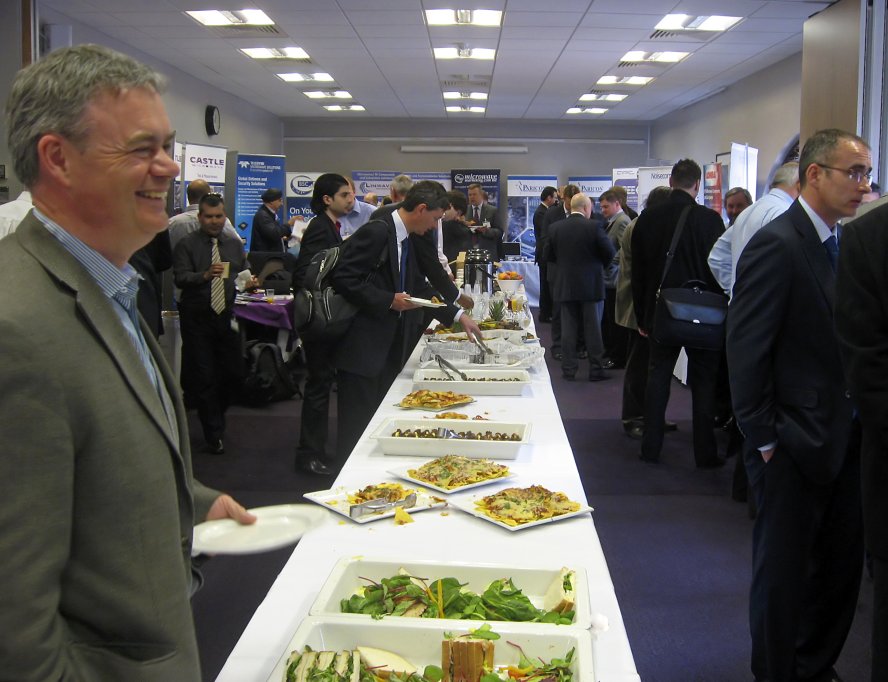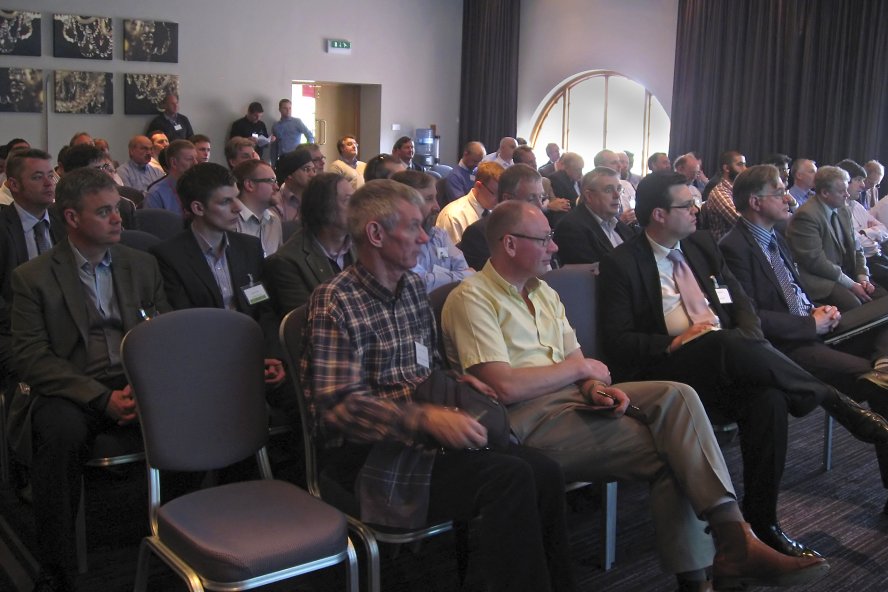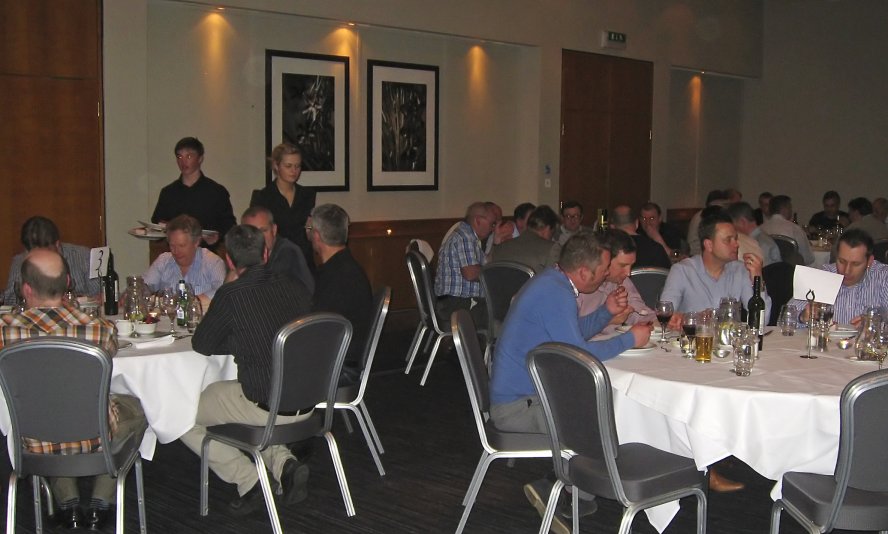The April 2013 was held at Milton Hill House in Oxfordshire. The conference was fully booked several weeks beforehand and was a great success.
The ARMMS RF & Microwave Society again provided sponsorship to two young engineers (28 or below) who had papers accepted at this meeting. Sponsorship awards of £100 cash were made plus free attendance (including conference dinner and overnight accommodation). The £100 prize for the best paper was awarded to Robert Smith for his presentation entitled "Broadband Push-Pull Power Amplifier Design at Microwave Frequencies".
 |  |  |
Milton Hill House
Steventon
Oxfordshire
OX13 6AF
| Tel | 0870 609 1153 |
| Web | http://www.deverevenues.co.uk/locations/milton-hill-house.html |
John Walker
Integra Technologies, Inc.
A Review of Applications for High Power GaN HEMT Transistors and MMICs | |
| Ray Pengelly and Chris Harris | |
| Cree | |
As the state-of-the-art in solid state device technology advances, vacuum tube microwave devices used in high power electromagnetic systems as well as military radar systems are being replaced with solid state power amplifiers (SSPA’s). Wide bandgap semiconductor materials like GaN HEMTs have potential to operate at power densities many times higher than Si-LDMOS, GaAs FET, and silicon carbide (SiC) devices. A summary of TWTA versus SSPA advantages and disadvantages will be described with some concentration on a comparison between tube-based and GaN HEMT based broadband amplifiers for EMC applications where VSWR withstand and general application robustness is important. The paper describes the important topic of wide bandgap transistor thermal management in terms of die design as well as die attach and heat sink material efficacy. Examples of commercially available high power GaN HEMT transistors and MMICs are given covering single device power levels up to 600 watts and frequencies up to 14.5 GHz. Extensive examples of various PA hardware are presented including the three common methods of power combining – corporate, radial and spatial, all of which offer graceful PA output power degradation in the unlikely event of device failure. Examples are provided for PA pallets with output powers as high as 10 kW and frequencies as high as 95 GHz. | |
| A Review of Applications for High Power GaN HEMT Transistors and MMICs | |
Addressing Frequency Drift in Tunable Filters | |
| Mehmet Karaaslan | |
| Teledyne Defence | |
Narrowband resonant circuits exhibit degradation in performance and frequency shift when component characteristics vary due to environmental effects. When the variation is predictable and repeatable, it can be addressed at the design stage by using electronic calibration methods and mechanical sealing. When the variation occurs unpredictably and especially during operation, sophisticated solutions like built-in-test or auto-correction may be needed to counter. This article presents data on such variation and effects on the performance of an X-band tunable bandstop filter as well as the effectiveness of actions to address the variation. | |
| Addressing Frequency Drift in Tunable Filters | |
Broadband Push-Pull Power Amplifier Design at Microwave Frequencies | |
| Robert Smith and Steve Cripps | |
| Cardiff University | |
A broadband, high efficiency push-pull power amplifier is presented between 0.5GHz and 1.5GHz. Coaxial cable transmission line baluns are utilised to transform the impedance environment of the transistors down to 25Ω, greatly simplifying the matching, whilst still providing a 50Ω environment to interface with other components. Using packaged GaN HEMT transistors, typical output powers of 45dBm and efficiencies of 44% to 75% have been measured across a 3:1 bandwidth. The small signal input match is less than −10dB and small signal gain is greater than 10dB across the entire band. | |
| Broadband Push-Pull Power Amplifier Design at Microwave Frequencies | |
Design of RF/microwave Amplifiers for Maximum Power Using Harmonic Balance Simulation when the only Available Data are the Transistor's Small Signal S-parameters | |
| Ivan Boshnakov | |
| Amplifier Technology | |
This presentation describes a method of designing RF/microwave power amplifiers using harmonic balance simulation when no non-linear models are available but only S-parameters or linear models. The design method described has its basis in the Cripps’s Load-Line Approach and Pieter Abrie’s power parameters method and could be considered as an addition to them. | |
| Design of RF/microwave Amplifiers for Maximum Power Using Harmonic Balance Simulation when the only Available Data are the Transistor's Small Signal S-parameters | |
Designing Cost Competitive E-band Radio Front-ends | |
| Liam Devlin | |
| Plextek RF Integration | |
E-band spectrum at 71 to 76GHz and 81 to 86GHz offers worldwide availability of wide operating bandwidths under a light license system. This makes it attractive for very high data rate applications such as cellular backhaul. The development of E-band radios with adequate performance at commercially acceptable prices holds a number of significant challenges. These include component availability, performance and cost as well as the engineering difficulties associated with implementing and manufacturing the radio. This paper describes these challenges and discusses the best approaches for addressing them. | |
| Designing Cost Competitive E-band Radio Front-ends | |
Fast-tuned Active High-Q X-Band Filters | |
| Husein Masoum, Peter Forrest and Jim Mayock (Viper RF Ltd) | |
| Teledyne Defence Limited | |
Modern warships need to rapidly detect incoming RF threats, but the Electronic Support Measures (ESM) sensors can be blinded by on-board systems such as Frequency Agile Active Electronic Scanned Array (FA AESA) radars. These high duty cycle emitters present a serious problem for ESM systems, as traditional protection methods such as simple band-stop filters or pulse blanking will significantly degrade the Probability Of Interception (POI) of the threat signals. This paper will first present a Fast Tuned Notch Filter (FTNF) that provides protection against FA AESA systems with negligible impact on threat POI. The paper will then present a second generation design that takes the original concept and moves it from a large, high-component-count, duroid-based design to a 2mm square piece of GaAs die with significantly improved performance. | |
| Fast-tuned Active High-Q X-Band Filters | |
Inducing Signal Integrity Issues using Noise | |
| Lee McMillan | |
| Noisecom | |
Computers, smart phones and other electronic equipment use a wide combination of digital and analog ICs. Increased data/clock rates and densely packing these active components creates an ideal environment for both electromagnetic interference (EMI) and other undesirable effects. This paper will present NoiseCom’s JV9000 and J9000 series of products and demonstrate how they are used to aid in the evaluation and verification phase of designing these modern high speed ICs. | |
| Inducing Signal Integrity Issues using Noise | |
Intrinsic Cree GaN HEMT Models Allow More Accurate Waveform Engineered PA Designs | |
| Ray Pengelly and Bill Pribble | |
| Cree | |
Following a brief review of the advantages of GaN HEMT transistors compared to other technologies and an overview of Cree’s well-proven GaN HEMT large-signal models, a new 6 port, so-called “intrinsic”, transistor model is introduced. This model gives direct access to the drain current generator ports as well as automatically “de-embedding” package parasitics (for packaged devices) and drain-to-source capacitance. Such a model allows a more accurate simulation of voltage and current waveforms and dynamic load-lines at the “intrinsic” transistor. With the increasing popularity of wave-form engineered PA’s such as Class F, inverse Class F, continuous Class F etc. to improve efficiencies and instantaneous bandwidths it is important to be able to properly match the transistor(s) and terminate the harmonics such that the intrinsic transistor drain voltage and current waveforms emulate ideal conditions such as half-sinusoid and square in anti-phase. Three examples of the use of this new modeling approach will be presented. The first example investigates the waveforms and load-lines of a narrow-band, 120 watt, S-Band amplifier using the Cree CGH40120F transistor where three harmonic impedances are used both in the input and output matching. The second example shows the use of the 6 port model in a 2 GHz amplifier, employing the Cree CGH40025F transistor, with respect to output mis-match robustness. VSWR’s of 10:1 with arbitrary phase are presented to the PA and the maximum excursions in drain voltage and current are determined. In addition, since the model incorporates a self-heating feature, transistor channel temperature can also be monitored. Such analyses allow the designer to ascertain whether a PA under VSWR mis-match conditions is likely to fail owing to extreme voltage or current overdrive or over-heating. The final example involves a low-power Doherty PA (using Cree CGH40010F transistors) where the voltage and current waveforms as well as dynamic load-lines of both the main and peaker amplifiers are investigated as a function of RF input drive level. The example clearly indicates the power of the new 6 port model in allowing visualization of waveforms, particularly as the peaker amplifier “turns on” and the effect of the active load pull of the peaker on the waveforms at the main amplifier. | |
| Intrinsic Cree GaN HEMT Models Allow More Accurate Waveform Engineered PA Designs | |
Measurement of Complex Dielectric Constant of Solids and Liquids over Frequency Range of 1 to 4 GHz Using Coaxial Cavity | |
| Adam Aboutaleb and Chris H Oxley | |
| De Montfort University | |
Accurate microwave dielectric measurement of materials is necessary data for the design engineer during the development stage of electronic and communication components. Several techniques have been published in recent years for measurement of dielectric properties of materials at microwave frequencies. Each of these techniques has some limitations in terms of accuracy and frequency coverage. This paper presents a novel method based on coaxial transmission line for the measurements of dielectric properties of a wide range of materials in the frequency range of 1 GHz to 4 GHz. A combined analytical-numerical method for conversion of smoothed transmission scattering ( ) parameters to complex permittivity is also presented. The measurement method was validated using air, low-loss solid and a high-loss liquid. The technique was then used to investigate the microwave absorption of an iron complexed and ligated to polyarylonitrile yarn powder. | |
| Measurement of Complex Dielectric Constant of Solids and Liquids over Frequency Range of 1 to 4 GHz Using Coaxial Cavity | |
Measurement of Fast Settling Microwave Synthesizers | |
| Richard Fawley and Alex Scarbro | |
| Teledyne Defence | |
Microwave synthesisers employed in electronic-warfare applications are required to possess performance attributes that place extreme demands on the test and measurement methods utilized. Specifically, the task of measuring frequency switching speed over a large bandwidth with sufficient fidelity is non-trivial. This paper presents a method of real-time analysis of frequency settling time using automated test routines. Issues related to achieving the required measurement fidelity are discussed, along with a summary of the theoretical performance bounds for frequency estimation. | |
| Measurement of Fast Settling Microwave Synthesizers | |
Modelling of a Planar VHF Balun Using E-M Simulation Techniques | |
| Dominic Fitzpatrick | |
| PoweRFul Microwave | |
One route to high efficiency amplifiers is to construct a balanced design. In this topology the two ‘halves’ are driven 180° out of phase; the structures that create these phase shifts are traditionally called Baluns – BALanced to UNbalanced. Commonly these are constructed from coaxial cables often incorporating ferrites; an alternative approach using planar transmission lines has cost and assembly advantages but has suffered from being difficult to design, partly due to a lack of adequate suspended stripline models. This paper sets out an approach using an Electro-Magnetic simulator which can quickly and accurately design such dividing and combining structures. | |
| Modelling of a Planar VHF Balun Using E-M Simulation Techniques | |
Non-Invasive Testing of RF Packaged Devices | |
| Stuart Hepburn | |
| Paricon Technologies | |
As the world of Integrated Circuitry soars higher in frequency, and complexity, but forever smaller in size, how do we the test these devices? The answer may lie with an anisotropically conductive material that is referred to as PariPoser Interconnects. PariPoser material makes electrical connections uniformly between opposing contact areas using conductive columns that are regularly distributed within a sheet of advanced polymer. Pariposer material has been demonstrated as being a very low loss interconnection at frequencies well above 60 GHz, and has resulted in a range of interconnection products for use in both test and production applications. | |
| Non-Invasive Testing of RF Packaged Devices | |
Nonlinear High Power Amplifier Modelling and Design for Efficient Multichannel Operation | |
| Andy Sheratt | |
| Thales | |
Paper withdrawn due to clearance difficulties.. | |
| Nonlinear High Power Amplifier Modelling and Design for Efficient Multichannel Operation | |
On the use of the Auxiliary Generator Technique to Improve Non-linear Microwave Circuit Analysis and Design | |
| Jose Luis Flores and Almudena Suarez | |
| Cantabria University | |
We present a simulation technique which is very easily implemented in AWRDE Microwave Office and can help Harmonic Balance to converge to a new set of stationary solutions, which may be present in a real circuit but do not show up during normal simulations due to intrinsic limitations of the frequency domain methods such as the Harmonic Balance algorithm. We discuss non convergence problems with Harmonic Balance and likely causes for differences between simulated and measured results. We give some basic insights into the different approaches of the time domain and frequency domain analysis tools. | |
| On the use of the Auxiliary Generator Technique to Improve Non-linear Microwave Circuit Analysis and Design | |
Ultra Wideband, High Efficiency RF Power Amplifier based on GaN HEMTs | |
| Diego Madueno-Pulido, Francisco Javier Ortega-Gonzalez, Jose Mauel Pardo-Martin et al | |
| Indra | |
This paper shows a new ultra wideband, high efficiency RF power amplifier based on a GaN HEMT transistor (CGH40090PP from Cree Inc.). This amplifier provides more than 50 W of output power from 20 MHz to 1400 MHz (almost two decades) and exhibits a drain efficiency up to 50%. The gain of the power stage of the amplifier is GP = 17 dB in saturation conditions and reaches 22 dB in small signal operation, gain flatness is ±1 dB all over its operation. The topology of the amplifier is a balanced Class-AB one and its input and load networks are made of coaxial transmission line transformers loaded with ferrite cores that provide both impedance transformation and balancing functions. For the best of the knowledge of the authors of this paper the performance of this amplifier improves previously published and commercial amplifiers for the same frequency band and output power level. | |
| Ultra Wideband, High Efficiency RF Power Amplifier based on GaN HEMTs | |
Wideband Class B Amplifiers for Split Frequency Envelope Modulated RF Power Amplifiers | |
| Gavin Watkins | |
| Toshiba | |
Envelope modulation is an efficient means of amplifying high dynamic range signals like LTE. Overall efficiency is the product of the RF amplifier’s and the envelope modulator’s efficiencies. In the split frequency modulator architecture, the linear amplifier has the largest effect on overall performance. This paper examines a number of linear amplifier architectures. For high efficiency, a class G complementary current mode amplifier achieves 72% modulator efficiency at 17W output power with a 3MHz bandwidth LTE signal. For bandwidth a class B totem pole amplifier achieves 62% efficiency at 9W output power with a 20MHz bandwidth LTE signal. | |
| Wideband Class B Amplifiers for Split Frequency Envelope Modulated RF Power Amplifiers | |
The conference was be accompanied by a commercial exhibition. Any companies interested in exhibiting at future meetings should contact the exhibition organiser John Kitchen on 0333 123 4640 or by email: exhibition@armms.org
This meeting was sponsored by Teledyne Microwave Solutions UK (http://www.teledynemicrowave.com/)
Contributions are invited with an emphasis on RF and microwave design, research, testing and associated subjects. An oral presentation will be made at the meeting and a written paper will be required for publication in the society digest, which is distributed to delegates at the meeting. Prospective speakers are requested to submit a title and a short abstract to the technical coordinator (see above) as soon as possible.
Click here to view our Guidelines for Authors
Click here to view our Publication Release Form